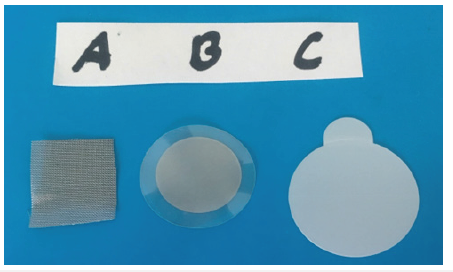- Submissions

Full Text
Annals of Chemical Science Research
New Modified Thin PDMS Membranes for IMS Detection of Volatile Chemical Agents
Wojciech Fabianowski and Miroslaw Maziejuk*
Military Institute of Chemistry and Radiometry, Warsaw, Poland
*Corresponding author:Miroslaw Maziejuk, Military Institute of Chemistry and Radiometry, Warsaw, Poland
Submission: October 28, 2022;Published: November 03, 2022

Volume3 Issue3November , 2022
Abstract
Detectable warfare agents in soil is important problem after using them. Now this problem are urgent and it should be prepared technics to detect warfare agents from soil and vapors from soil. One of most common methods is using devices base on Ion Mobility Spectrometry. In this communicate we propose possibility to increase membrane sensitivity and selectivity, to develop relatively simple method to detect warfare agents in the soil. To increase sensitivity and to reduce detection time in the Ion Mass Spectroscopy detectors there are required thin Polydimethylsiloxane PDMS membranes impermeable to the water vapors and permeable, selective to the tested volatile chemical agents. To obtain mechanically strong and thin PDMS membranes a porous supports were applied and to increase permeability of chemical agents addition of selected poly(ethylene oxides) were tested.
Membranes for Ion Mass Spectroscopy Detectors
In the IMS instruments in the gas inlet port, prior to the Ni-63 ionization chamber there is placed Polydimethylsiloxane PDMS membrane, which is impermeable to the water vapor and on the other hand permeable to the tested volatile organic agents. Membrane permeability P depends on the Diffusion and Solubility of tested compounds
P = D x S
To increase the Diffusion D there are required relatively thin PDMS membranes, which also has to be mechanically strong and resistant to the varied pressures [1,2]. We have decided to test different mechanical porous supports (Figure 1), which will be modified with PDMS/ Hexane (Sylgard 184) 10% w/w solution to obtain after drying and hot temperature curing (120 ˚C for 2 hours) films with thicknesses in the range of 3-5μm only.
Figure 1:Mechanical porous supports for thin PDMS membranes: A-stainless steel screen; B-PET laser track membrane with 8 μm openings; C-ceramic alumina porous foil.

To increase solubility S of tested volatile chemical agents we have decided to add to the PDMS matrix membrane 20phr of poly(ethylene oxide) PEO; poly(propylene oxide) PPO or calixarene derivative with different molecular masses, total 6 additives are tested.
Colorimetric Detection of Volatile Organic Agents
In the experimental procedures, studying different mechanical supports, PDMS membranes with varied thicknesses and added modifying additives there is necessary to use a fast and reliable method for testing permeability of different chemical compounds, especially volatile simulants of the Chemical Warfare Agents CWA [3]. We have decided to use Paper Chemical Agent Detector 6665- 21-858-8494 [4] which in contact with liquid CWA agents rapidly changes color (Figure 2).
Figure 2: Brown self-sticking paper colorimetric detector (right) changing rapidly colour after contact with liquid CWA (left).

But there is an open question how these colorimetric detectors will react in contact with not liquid but vapor form of chemical agent. We are running experiments with different PDMS membranes, covering paper detector and observing how this covering membrane is affecting the reaction time-change of the color. On Figure 3 (a-c) there are presented results of visual observations of paper colorimetric detectors being placed in coverings of glass 10 ml vials over 20μl of CWA liquid simulants (methyl phosphonic acid dimethyl ester DMMP; Methyl Salicylate SM; Dimethoxy propanol DPGM).
Table 3a:Paper detectors placed in RT 70 mm over drops of liquid DMMP; SM; DPGM simulants.

Table 3b:Paper detectors placed in RT 70 mm over drops of liquid DMMP; SM; DPGM simulants after 48 hours.

Table 3c:Paper detectors placed in RT 70 mm over drops of liquid DMMP; SM; DPGM simulants after 168 hours.

Note color change of paper detector in contact with vapor phase of DMMP (turn brown) and SM (turns red). For DPGM simulants we do not observe color change, both in liquid and in the gas phase.
<Conclusion
Paper colorimetric detectors can be used for testing different PDMS membranes to select the best one for the IMS instrument. We want to select a thin membrane, relatively strong due to the presence of mechanical support and modified with PEO or PPO derivatives rapidly reacting to the CWA simulants action in the gas phase.
References
- Dalia E Abulyazied, Antoaneta Ene (2021) An investigative study on the progress of nanoclay-reinforced polymers: Preparation, properties and applications: A Review. Polymers 13(24): 4401.
- Gamze Cakir Kabakci, Ozgur Aslan, Emin Bayraktar (2021) Toughening mechanism analysis of recycled rubber-based composites reinforced with glass bubbles, glass fibers and alumina fibers. Polymers 13(23): 4215.
- Jayne A Ede, Peter J Cragg, Mark R Sambrook (2018) Comparison of binding affinities of water-soluble calixarenes with the organophosphorus nerve agent soman (Gd) and commonly-used nerve agent simulants. Molecules 23(1): 207.
- http://www.tradewaysusa.com/Catalogue-New/Detection_&_Identification/Chemical/Detector%20Paper/3Way.pdf
© 2022 Miroslaw Maziejuk. This is an open access article distributed under the terms of the Creative Commons Attribution License , which permits unrestricted use, distribution, and build upon your work non-commercially.
 a Creative Commons Attribution 4.0 International License. Based on a work at www.crimsonpublishers.com.
Best viewed in
a Creative Commons Attribution 4.0 International License. Based on a work at www.crimsonpublishers.com.
Best viewed in 







.jpg)






























 Editorial Board Registrations
Editorial Board Registrations Submit your Article
Submit your Article Refer a Friend
Refer a Friend Advertise With Us
Advertise With Us
.jpg)






.jpg)














.bmp)
.jpg)
.png)
.jpg)










.jpg)






.png)

.png)



.png)






